二十四节气_中英讲解
- 格式:ppt
- 大小:3.80 MB
- 文档页数:32
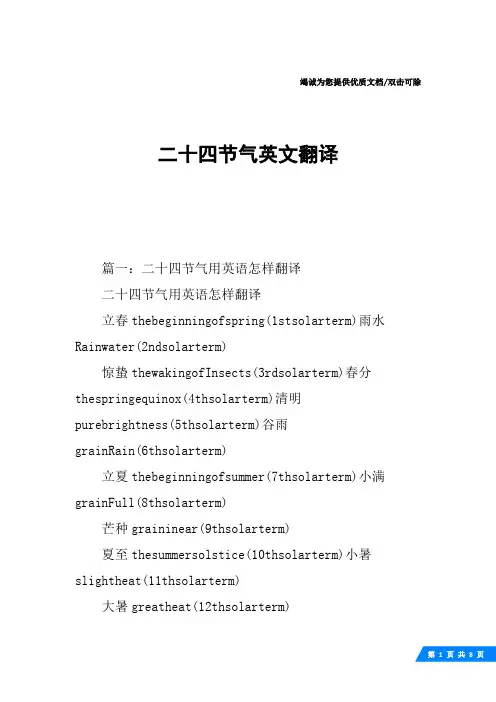
竭诚为您提供优质文档/双击可除二十四节气英文翻译篇一:二十四节气用英语怎样翻译二十四节气用英语怎样翻译立春thebeginningofspring(1stsolarterm)雨水Rainwater(2ndsolarterm)惊蛰thewakingofInsects(3rdsolarterm)春分thespringequinox(4thsolarterm)清明purebrightness(5thsolarterm)谷雨grainRain(6thsolarterm)立夏thebeginningofsummer(7thsolarterm)小满grainFull(8thsolarterm)芒种graininear(9thsolarterm)夏至thesummersolstice(10thsolarterm)小暑slightheat(11thsolarterm)大暑greatheat(12thsolarterm)立秋thebeginningofAutumn(13thsolarterm)处暑theLimitofheat(14thsolarterm)白露whiteDew(15thsolarterm)秋分theAutumnalequinox(16thsolarterm)寒露coldDew(17thsolarterm)霜降Frost′sdescent(18thsolarterm)立冬thebeginningofwinter(19thsolarterm)小雪slightsnow(20thsolarterm)大雪greatsnow(21stsolarterm)冬至thewintersolstice(22ndsolarterm)小寒slightcold(23rdsolarterm)大寒greatcold(24thsolarterm)篇二:二十四节气中英文对照二十四节气中英文对照二十四节气是中国古代订立的一种用来指导农事的补充历法,是中国古代汉族劳动人民长期经验的积累和智慧的结晶。
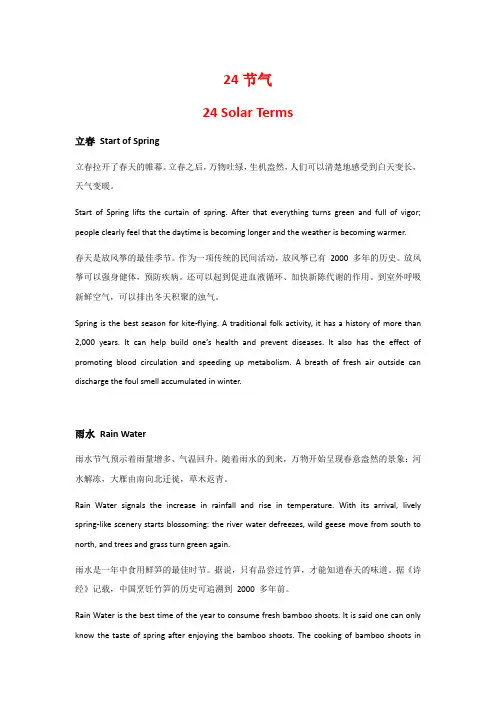
24节气24 Solar Terms立春Start of Spring立春拉开了春天的帷幕。
立春之后,万物吐绿,生机盎然,人们可以清楚地感受到白天变长,天气变暖。
Start of Spring lifts the curtain of spring. After that everything turns green and full of vigor; people clearly feel that the daytime is becoming longer and the weather is becoming warmer.春天是放风筝的最佳季节。
作为一项传统的民间活动,放风筝已有2000 多年的历史。
放风筝可以强身健体,预防疾病。
还可以起到促进血液循环、加快新陈代谢的作用。
到室外呼吸新鲜空气,可以排出冬天积聚的浊气。
Spring is the best season for kite-flying. A traditional folk activity, it has a history of more than 2,000 years. It can help build one’s health and prevent diseases. It also has the effect of promoting blood circulation and speeding up metabolism. A breath of fresh air outside can discharge the foul smell accumulated in winter.雨水Rain Water雨水节气预示着雨量增多、气温回升。
随着雨水的到来,万物开始呈现春意盎然的景象:河水解冻,大雁由南向北迁徙,草木返青。
Rain Water signals the increase in rainfall and rise in temperature. With its arrival, lively spring-like scenery starts blossoming: the river water defreezes, wild geese move from south to north, and trees and grass turn green again.雨水是一年中食用鲜笋的最佳时节。
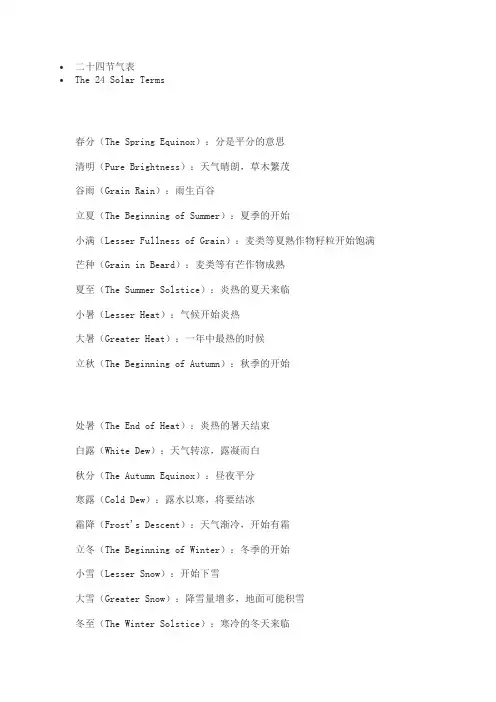
•二十四节气表•The 24 Solar Terms春分(The Spring Equinox):分是平分的意思清明(Pure Brightness):天气晴朗,草木繁茂谷雨(Grain Rain):雨生百谷立夏(The Beginning of Summer):夏季的开始小满(Lesser Fullness of Grain):麦类等夏熟作物籽粒开始饱满芒种(Grain in Beard):麦类等有芒作物成熟夏至(The Summer Solstice):炎热的夏天来临小暑(Lesser Heat):气候开始炎热大暑(Greater Heat):一年中最热的时候立秋(The Beginning of Autumn):秋季的开始处暑(The End of Heat):炎热的暑天结束白露(White Dew):天气转凉,露凝而白秋分(The Autumn Equinox):昼夜平分寒露(Cold Dew):露水以寒,将要结冰霜降(Frost's Descent):天气渐冷,开始有霜立冬(The Beginning of Winter):冬季的开始小雪(Lesser Snow):开始下雪大雪(Greater Snow):降雪量增多,地面可能积雪冬至(The Winter Solstice):寒冷的冬天来临小寒(Lesser Cold):气候开始寒冷大寒(Greater Cold):一年中最冷的时候【知识延伸】明代有一位学台,在浙江天台山游览时,夜宿山中茅屋。
次日晨起,见茅屋一片白霜,心有所感,随口吟出一幅上联:昨夜大寒,霜降茅屋如小雪。
联中嵌有三个节气,一气呵成,毫无痕迹,一时成为绝对。
直至近代,才由浙江的赵恭沛先生对出下联:今朝惊蛰,春分时雨到清明。
一样三个节气,对得十分工整。
在如今的城市,除了周末,人们已经不太感知得到时间的意义。
但在传统社会,人们对自然与天时的感知是细腻的。
时间从农民那里转移,在土地里抽象升华,圣贤才士对时间深究研思,并寻找到幸福的源泉,获得生命的真谛。
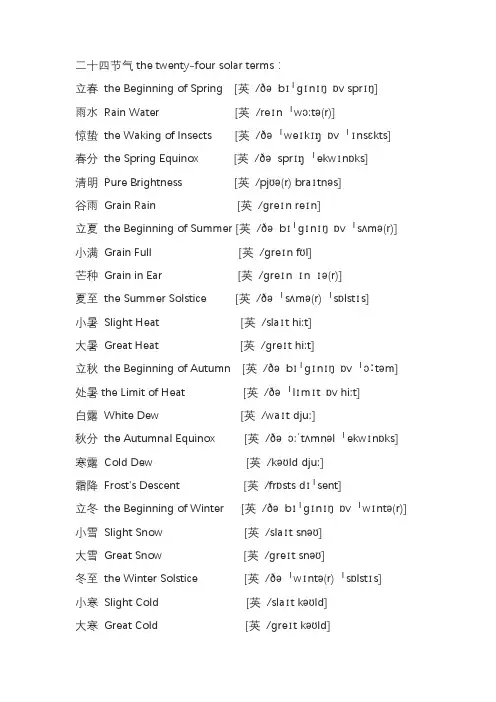
二十四节气the twenty-four solar terms:立春the Beginning of Spring [英/ðəbɪˈɡɪnɪŋɒv sprɪŋ]雨水Rain Water [英/reɪn ˈwɔːtə(r)]惊蛰the Waking of Insects [英/ðəˈweɪkɪŋɒv ˈɪnsɛkts]春分the Spring Equinox [英/ðəsprɪŋˈekwɪnɒks]清明Pure Brightness [英/pjʊə(r) braɪtnəs]谷雨Grain Rain [英/ɡreɪn reɪn]立夏the Beginning of Summer [英/ðəbɪˈɡɪnɪŋɒv ˈsʌmə(r)] 小满Grain Full [英/ɡreɪn fʊl]芒种Grain in Ear [英/ɡreɪn ɪn ɪə(r)]夏至the Summer Solstice [英/ðəˈsʌmə(r) ˈsɒlstɪs]小暑Slight Heat [英/slaɪt hiːt]大暑Great Heat [英/ɡreɪt hiːt]立秋the Beginning of Autumn [英/ðəbɪˈɡɪnɪŋɒv ˈɔːtəm] 处暑the Limit of Heat [英/ðəˈlɪmɪt ɒv hiːt]白露White Dew [英/waɪt djuː]秋分the Autumnal Equinox [英/ðəɔːˈtʌmnəl ˈekwɪnɒks] 寒露Cold Dew [英/kəʊld djuː]霜降Frost's Descent [英/frɒsts dɪˈsent]立冬the Beginning of Winter [英/ðəbɪˈɡɪnɪŋɒv ˈwɪntə(r)] 小雪Slight Snow [英/slaɪt snəʊ]大雪Great Snow [英/ɡreɪt snəʊ]冬至the Winter Solstice [英/ðəˈwɪntə(r) ˈsɒlstɪs]小寒Slight Cold [英/slaɪt kəʊld]大寒Great Cold [英/ɡreɪt kəʊld]二十四节气歌春雨惊春清谷天,夏满芒夏暑相连。
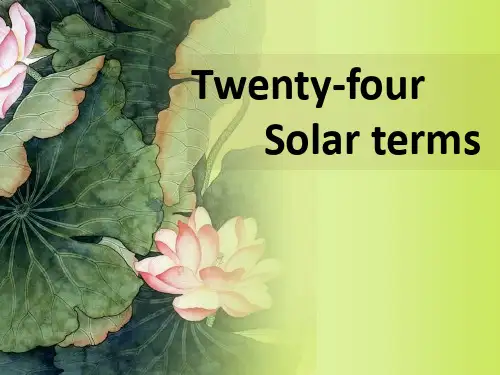
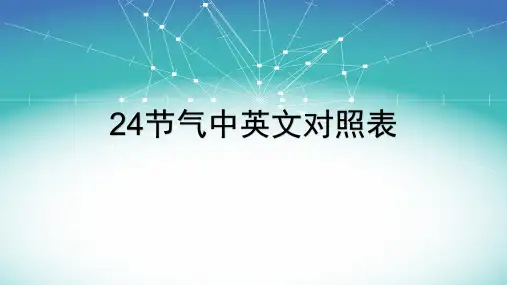
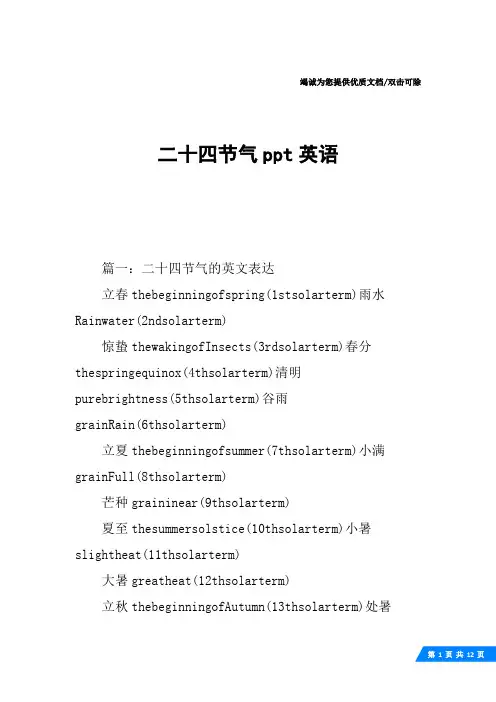
竭诚为您提供优质文档/双击可除二十四节气ppt英语篇一:二十四节气的英文表达立春thebeginningofspring(1stsolarterm)雨水Rainwater(2ndsolarterm)惊蛰thewakingofInsects(3rdsolarterm)春分thespringequinox(4thsolarterm)清明purebrightness(5thsolarterm)谷雨grainRain(6thsolarterm)立夏thebeginningofsummer(7thsolarterm)小满grainFull(8thsolarterm)芒种graininear(9thsolarterm)夏至thesummersolstice(10thsolarterm)小暑slightheat(11thsolarterm)大暑greatheat(12thsolarterm)立秋thebeginningofAutumn(13thsolarterm)处暑theLimitofheat(14thsolarterm)白露whiteDew(15thsolarterm)秋分theAutumnalequinox(16thsolarterm)寒露coldDew(17thsolarterm)霜降Frost′sdescent(18thsolarterm)立冬thebeginningofwinter(19thsolarterm)小雪slightsnow(20thsolarterm)大雪greatsnow(21stsolarterm)冬至thewintersolstice(22ndsolarterm)小寒slightcold(23rdsolarterm)大寒greatcold(24thsolarterm)篇二:24节气中英对照中英二十四节气春季spring立春thebeginningofspring2月3-5日雨水Rainwater2月18-20日惊蛰thewakingofInsects3月5-7日春分Vernalequinox3月20-22日清明purebrightness4月4-6日谷雨grainrain4月19-21日夏季summer立夏thebeginningofsummer5月5-7日小满LesserFullnessofgrain5月20-27日芒种graininear/beard6月5-7日夏至summersolstice6月21-22日小暑slight/Lesserheat7月6-8日大暑greatheat7月22-24日秋季Autumn立秋thebeginningofAutumn8月7-9日处暑stoppingtheheat8月22-24日白露whitedews9月7-9日秋分Autumnequinox9月22-24日寒露colddews10月8-9日霜降hoar-frostfalls/descends10月23-24日冬季winter立冬thebeginningofwinter11月7-8小雪Light/Leasersnow11月22-23日大雪heavy/greatersnow12月6-8日冬至wintersolstice12月21-23日小寒slight/Lessercold1月5-7日大寒greatcold1月20-21日二十四节气歌春雨惊春清谷天,夏满芒夏暑相连。
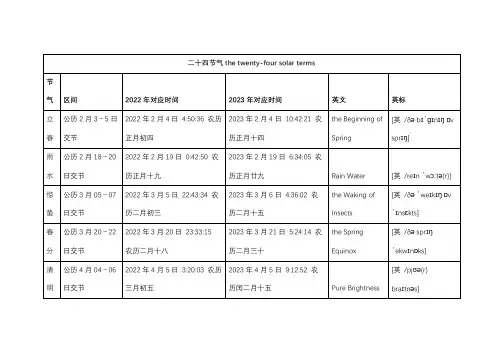
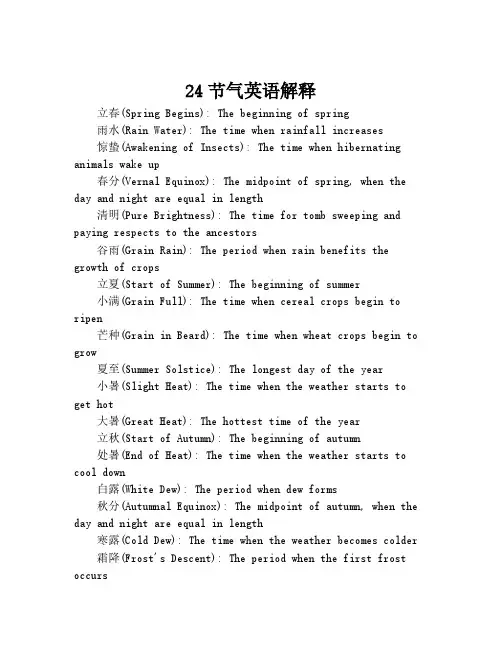
24节气英语解释立春(Spring Begins): The beginning of spring雨水(Rain Water): The time when rainfall increases惊蛰(Awakening of Insects): The time when hibernating animals wake up春分(Vernal Equinox): The midpoint of spring, when the day and night are equal in length清明(Pure Brightness): The time for tomb sweeping and paying respects to the ancestors谷雨(Grain Rain): The period when rain benefits the growth of crops立夏(Start of Summer): The beginning of summer小满(Grain Full): The time when cereal crops begin to ripen芒种(Grain in Beard): The time when wheat crops begin to grow夏至(Summer Solstice): The longest day of the year小暑(Slight Heat): The time when the weather starts to get hot大暑(Great Heat): The hottest time of the year立秋(Start of Autumn): The beginning of autumn处暑(End of Heat): The time when the weather starts to cool down白露(White Dew): The period when dew forms秋分(Autumnal Equinox): The midpoint of autumn, when the day and night are equal in length寒露(Cold Dew): The time when the weather becomes colder 霜降(Frost's Descent): The period when the first frost occurs立冬(Start of Winter): The beginning of winter小雪(Slight Snow): The time when the first snowfall occurs大雪(Heavy Snow): The period when the snowfall increases 冬至(Winter Solstice): The shortest day of the year小寒(Slight Cold): The time when the weather becomes colder大寒(Great Cold): The coldest time of the yearThese are the explanations of the 24 solar terms in English. Each term represents a specific period of time and has its own significance in traditional Chinese culture. Understanding these terms helps us to better appreciate the changes in nature and the passing of seasons.。

二十四节气(中英双语)二十四节气(24 Solar terms)分别是:立春 Beginning of Spring,雨水 Rain Water,惊蛰Awakening of Insects (Waking of Insects),春分 Spring Equinox,清明 Pure Brightness,谷雨 Grain Rain,立夏 Beginning of Summer,小满Grain Buds (Grain Full / Lesser Fullness),芒种Grain in Ear,夏至 Summer Solstice,小暑 Minor Heat (Slight Heat),大暑 Major Heat (Great Hight),立秋 Beginning of Autumn,处暑 End of Heat (Limit of Heat),白露 White Dew,秋分 Autumn Equinox,寒露 Cold Dew,霜降 Frost’s Descent,立冬 Beginning of Winter,小雪 Minor Snow (Slight Snow),大雪 Major Snow (Great Snow),冬至 Winter Solstice,小寒 Minor Cold (Slight Cold),大寒 Major Cold (Great Cold)。
The 24 solar terms are specific festivals in the traditional Chinese Lunisolar calendars that represent changes in natural rhythms. There are four seasons of one year, three months each in Spring, Summer, Autumn, and Winter, with two solar terms per month; each solar term has its unique meaning. Solar terms were initially based on the rotation of the Big Dipper in ancient times. The modern definition uses ecliptic longitudes, which divide the annual motion path of the Sun into 24 equal parts, with 1 equal part every 15 ° and 1 equal part as a solar term, starting from the Beginning of Spring and ending in Greater Cold.二十四节气是日历中特定的节日,代表着自然节奏的变化。
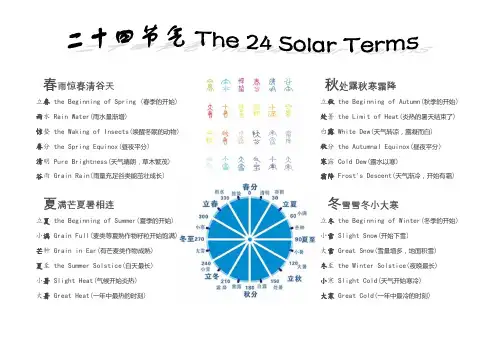
春雨惊春清谷天
立春 the Beginning of Spring (春季的开始) 雨水 Rain Water(雨水量渐增)
惊蛰 the Waking of Insects(唤醒冬眠的动物) 春分 the Spring Equinox(昼夜平分)
清明 Pure Brightness(天气晴朗,草木繁茂)
谷雨 Grain Rain(雨量充足谷类能茁壮成长)
夏满芒夏暑相连
立夏 the Beginning of Summer(夏季的开始) 小满 Grain Full(麦类等夏熟作物籽粒开始饱满) 芒种 Grain in Ear(有芒麦类作物成熟)
夏至 the Summer Solstice(白天最长)
小暑 Slight Heat(气候开始炎热)
大暑 Great Heat(一年中最热的时刻)
秋处露秋寒霜降
立秋 the Beginning of Autumn(秋季的开始) 处暑 the Limit of Heat(炎热的暑天结束了) 白露 White Dew(天气转凉,露凝而白)
秋分 the Autumnal Equinox(昼夜平分)
寒露 Cold Dew(露水以寒)
霜降 Frost's Descent(天气渐冷,开始有霜)
冬雪雪冬小大寒
立冬 the Beginning of Winter(冬季的开始) 小雪 Slight Snow(开始下雪)
大雪 Great Snow(雪量增多,地面积雪)
冬至 the Winter Solstice(夜晚最长)
小寒 Slight Cold(天气开始寒冷)
大寒 Great Cold(一年中最冷的时刻)。
二十四节气来历和英文翻译,节气歌二十四节气歌春雨惊春清谷天,夏满芒夏暑相连,秋处露秋寒霜降,冬雪雪冬小大寒。
上半年是六廿一,下半年来八廿三,每月两节日期定,最多不差一二天。
名称Name 开始日期Beginning立春the Beginning of Spring (1st solar term)Feb.3,4, or 5雨水Rain Water (2nd solar term)Feb.18,19 or 20惊蜇the Waking of Insects (3rd solar term)Mar.5,6, or 7春分the Spring Equinox (4th solar term)Mar.20,21 or 22清明Pure Brightness (5th solar term)Apr.4,5 or 6谷雨Grain Rain (6th solar term)Apr.19,20 or 21立夏the Beginning of Summer (7th solar term)May 5,6 or 7 小满Lesser Fullness of Grain (8th solar term)May 20,21 or 22 芒种Grain in Beard (9th solar term)Jun.5,6 or 7夏至the Summer Solstice (10th solar term)Jun.21 or 22小暑Lesser Heat (11th solar term)Jul.6,7 or 8大暑Greater Heat (12th solar term)Jul.22,23 or 24立秋the Beginning of Autumn (13th solar term)Aug.7,8 or 9 处暑the End of Heat (14th solar term)Aug.22,23 or 24 白露White Dew (15th solar term)Sep.7,8 or 9秋分the Autumn Equinox (16th solar term)Sep.22,23 or 24 寒露Cold Dew (17th solar term)Oct.8 or 9霜降Frost's Descent (18th solar term)Oct.23 or 24立冬the Beginning of Winter (19th solar term)Nov.7 or 8小雪Lesser Snow (20th solar term)Nov.22 or 23大雪Greater Snow (21th solar term)Dec.6,7 or 8冬至the Winter Solstice (22th solar term)Dec.21,22 or 23小寒Lesser Cold (23th solar term)Jan.5,6 or 7大寒Greater Cold (24th solar term)Jan.20 or 2二十四节气二十四节气是我国劳动人民独创的文化遗产,它能反映季节的变化,指导农事活动,影响着千家万户的衣食住行。
24节气中英文介绍Embedded deep within the agricultural heart of ancient China, the 24 Solar Terms offer a unique perspective on the rhythm of nature and the synchronization of human life with the cycles of the sun, moon, and earth. These terms, dating back over 2,000 years, provide a precise framework for understanding the agricultural calendar, weather patterns, and the changing seasons.The first Solar Term, "Li Chun," marks the beginning of spring, symbolizing the awakening of nature and the emergence of new life. As the sun's rays become more intense and the temperature rises, nature blossoms with flowers, and birds sing in celebration. This is a time of renewal and hope, a fresh start after the dormancy of winter."Yu Shui," the second Solar Term, heralds the arrival of the spring rains, nourishing the soil and preparing the fields for planting. The rain brings life to the parched earth, preparing it for the planting of crops that will sustain the people throughout the year."Ching Ming," the third Solar Term, is a time for commemoration and reflection, marked by the traditional custom of grave sweeping. It is also a time for plantingrice and other crops, symbolizing the cycle of life and death, renewal, and growth.As we progress through the Solar Terms, nature unfolds its wonders in a synchronized dance with the sun. "Gu Yu" brings the sounds of thunder and the scent of earth as the first rains of summer fall, marking the growth and maturity of crops. "Xia Man" heralds the arrival of the summer solstice, a time of intense heat and the longest day of the year.The mid-summer Solar Terms, "Da Wu" and "Xia Zhu," are marked by the ripening of crops and the peak of summer heat. This is a time of harvest and celebration, as the labor of the fields comes to fruition.As we enter the autumn season, the Solar Terms take ona different hue. "Li Qiu" marks the beginning of the autumn harvest, a time of reaping what was sown in the spring. "Bai Lu" brings the first frosts of the season, signaling the transition from summer's warmth to autumn's crispness."Han Lu" and "Xiao Xue" mark the deepening of the cold as winter approaches. These terms symbolize the dormancy of nature and the preparation for the next cycle of life. As the snows fall and the temperature plummets, the fields rest, waiting for the return of spring and the renewal of life.The 24 Solar Terms are not just a guide to agriculture; they are a philosophy of life, a way of understanding the interconnectedness of all things. They teach us to observe, to listen to the rhythms of nature, and to flow with the changes of the seasons. In this way, the Solar Terms offera profound wisdom that is as relevant today as it was in ancient times.**二十四节气:融合中国智慧与自然节律**深植于中国古代农业文化的核心,二十四节气提供了一种独特的视角,让我们理解自然的韵律和人类生活与太阳、月亮、地球周期之间的同步。